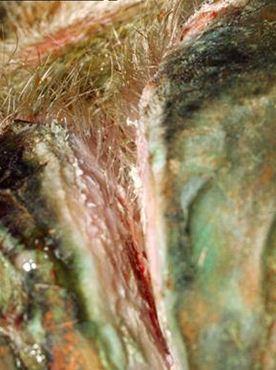Foot Rot in Cattle
In cattle different bacteria are involved in foot rot, the most important one being Fusobacterium. These bacteria are also present in faeces, which explains why the disease is more common in dirty environment and is also difficult to control.
CausesThe bacteria causing foot rot are normal residents of the environment of cattle but cannot penetrate healthy skin. Any injury to the foot and especially to the skin between the toes provides an entry for foot rot bacteria and allows these pathogens to infect the skin and the tissue underneath the skin. Injury occurs easier and more frequently in skin that has been softened by constant exposure to water, faeces and urine. Adult cattle are more commonly affected than younger animals and local breeds of cattle appear to more resistant than those of European breeds.
Signs of Foot Rot
|

|
Diseases with similar symptoms Leg and feet lesions: see above Foot and Mouth Disease
Prevention
- Keep the ground clean and dry, especially in zero grazing(!), you can use saw dust to keep the surface dry
- If you have concrete surface make sure the surface is very even and smooth - uneven and rough concrete surface causes injury to the hooves
- Frequently clean, sweep and scrape hard surfaces free of manure; remove dung and mud from the boma regularly
- Drain areas around drinking troughs, gateways and frequented tracks.
- Trim hooves regularly, any overgrowth should be cut off when you see it, always keep the hooves in normal shape
- Cows with soft hooves are more likely to suffer from foot rot, do not buy or keep offspring from such cows
Treatment
Treatment must begin as soon as possible!
- If there is already a large lesion, wash the foot especially the skin between the claws with hot water- as hot as you can put your hand in; then apply an antiseptic solution like dettol or similar; cut away or trim any decayed part of the hoof to remove the infection that is underneath it, remove all dead tissue using a clean pen-knife; treat surface with Hydrogen Peroxide 3% and cover with a wound powder/ointment (e.g. copper sulphate in the form of a blue paste); make sure the animal is kept on dry clean surface
Caution: when trimming the hooves inexperienced people may cut too deep causing extra injury - it is very good to watch an experienced stockman trimming hooves and learn from him
- After operating on the foot supportive treatment with antibiotics is necessary: good results are obtained with Procaine-Penicillin or Penicillin-Streptomycin IM for 3 days at double the normally recommended dose; long-acting Oxytetracycline also gives good results as does a three day course of Trimethroprim/Sulphadaizine IM
Common traditional practices
- Somali: Wash the foot with very salty water repeatedly until the animal recovers
(Source:ITDG and IIRR 1996)
